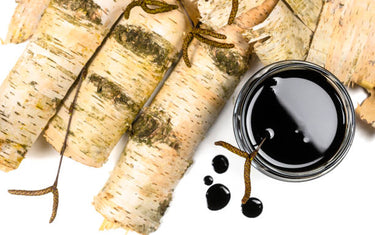5 min read / 4 December 2023 / yasmin sharp
10 Benefits and Uses of Sandalwood Oil
Explore the myriad benefits and versatile uses of sandalwood oil.
Share this post

The classic smell of sandalwood oil is known around the world, with the oil also being used as an ingredient base in countless products.
Sandalwood features prominently in aromatherapy treatments to help a variety of ailments and conditions, in the belief that it possesses a host of benefits that can improve mental and physical wellbeing.
To understand more about how helpful it could be, we look at some of the most common benefits and uses of sandalwood oil.
What is sandalwood oil?Sandalwood oil is extracted via steam distillation from the ground and dried wood of sandalwood trees that are native to India, northern Australia and the Malay Archipelago. It has a woody, sweet scent that is often used as a base for perfumes, incense and cosmetic products, as it tends to blend well with a wide variety of oils. When buying sandalwood essential oil, always check that it has a minimum free alcohol level of 90%, as this ensures it is not a synthetic product. |

Sandalwood essential oil benefits
Some of the main sandalwood oil benefits include its potential to:
1. Lower anxiety levels
Researchers have learned that sandalwood, orange-peppermint and lavender aromatherapy could help to lower anxiety levels.
This is based on a study of 87 women [1] undergoing a breast biopsy, who self-reported that their anxiety was lower after using the oils in aromatherapy.
Another study [2] found that after inhaling sandalwood and lavender oil, participants' blood pressure and cortisol levels were lower.
2. Fight skin cancer
Although additional research is required, an initial study published in 2014 [3] stated that a compound found in sandalwood oil may be able to fight skin cancer.
A-santalol is the name of the compound, which has been shown to engage with cell death induction [4] in various cancer models.
3. Aid wound healing
According to the results of a study published in 2014, [5] sandalwood oil benefits could also extend to the promotion of skin cell growth.
Researchers working on the study discovered that when skin cells containing olfactory receptors for sandalwood were activated, wounds were able to heal and repair more quickly.
4. Work as an anti-inflammatory
Some skin studies have also demonstrated that it could work as an anti-inflammatory.
Other studies, such as this one [6] published in 2019, stated that this benefit is triggered because the scent altered cell signalling in the body.
Researchers presented evidence that inflammation caused by skin disorders such as atopic dermatitis and psoriasis could be eased through topical application.
5. Promote better sleep
The deep, woody and slightly sweet aroma of sandalwood essential oil benefits many people who find it difficult to fall asleep at night.
The relaxing aroma promotes relaxation and comfort, making it easier to unwind before bedtime.
A 2007 study of rats [7] found that the a-santalol compound plays a key role in sedating them and decreasing their total waking time.

6. Protect against free radicals
Free radicals have been linked to several serious conditions, such as cancer, heart disease and neuro-degenerative disorders.
When free radical levels become too high it can lead to oxidative stress, which can impact the body in many ways.
Because sandalwood oil is rich in antioxidants, it can provide protection for the body against the damage caused by oxidative stress, ensuring fewer cells are affected.
7. Boost skin health
Sandalwood benefits the skin by acting as an astringent, allowing it to induce minor constrictions on soft tissues.
This is why you will often find sandalwood included in facial toners and aftershaves, as the properties of the oil help to soothe, tighten and cleanse the skin.
The antioxidant compounds can also be beneficial for revitalising the skin, which could also reduce the signs of ageing.
8. Provide antiseptic and antiviral protection
Researchers have found that sandalwood essential oil benefits can help to prevent the growth of common viruses, [8] such as herpes simplex viruses-1 and -2.
When diluted with a carrier oil, you can use the oil to reduce irritation and inflammation caused by minor wounds, boils, warts and pimples.
Gargling the oil with a cup of water can also help to ease a sore throat.
9. Treat urinary tract infections
The German Commission E, the official scientific advisory board for the country, has approved sandalwood oil for internal use to treat lower urinary tract infections.
However, there have been no double-blind, placebo-controlled clinical trials to investigate this claim further, which means there is currently no meaningful evidence that it works as an effective treatment.
10. Work as a natural aphrodisiac
Sandalwood has long been used as an aphrodisiac by practitioners of Ayurvedic medicine.
Whilst there is no scientific evidence to support this claim, the oil could be used to increase libido and may be able to help men with impotence.
The best way to try this is to use sandalwood as a massage oil or topical lotion on the skin.
What’s the best way to enjoy sandalwood oil benefits?
Sandalwood benefits can be enjoyed in many different ways at home, such as:
- Mixing a few drops of sandalwood oil with a cream or lotion.
- Using the oil in a diffuser or oil burner.
- Diluting the oil with a carrier oil (such as jojoba oil) and applying topically to your skin.
- Adding a few diluted drops of sandalwood oil to warm bath water.
- Making or using a candle or soap that includes sandalwood as an ingredient.
Some people can experience allergic reactions to essential oils, as they are highly concentrated due to their natural properties.
This can occur even if the oil has been diluted, so it is a good idea to complete a patch test before application.

Sandalwood essential oil benefits are wide and varied, with its natural anti-inflammatory, antiviral and antiseptic properties potentially improving your general wellbeing.
From lowering anxiety levels and aiding wound healing to supporting better sleep and boosting skin health, it’s an oil that not only smells great but offers medicinal support.
And there are lots of ways to intake these benefits, with inhalation, diffusion and topical applications just some of the methods you can use.
[1] Renee Trambert et al. (2017) A Randomized Controlled Trial Provides Evidence to Support Aromatherapy to Minimize Anxiety in Women Undergoing Breast Biopsy https://pubmed.ncbi.nlm.nih.gov/28395396/
[2] Martina Höferl et al. (2016) A Pilot Study on the Physiological Effects of Three Essential Oils in Humans https://pubmed.ncbi.nlm.nih.gov/30549622/
[3] Sally E. Dickinson et al. (2014) A novel chemopreventive mechanism for a traditional medicine: East Indian sandalwood oil induces autophagy and cell death in proliferating keratinocytes https://www.sciencedirect.com/science/article/abs/pii/S0003986114002239
[4] Ajay Bommareddy et al. (2017) Medicinal properties of alpha-santalol, a naturally occurring constituent of sandalwood oil: review https://pubmed.ncbi.nlm.nih.gov/29130352/
[5] Dr. Hanns Hatt (2014) Sandalwood scent facilitates wound healing and skin regeneration https://www.eurekalert.org/news-releases/523182
[6] Bhattacharjee Rajsmita and Vinay Keshavamurthy (2019) Re-discovering Sandalwood: Beyond Beauty and Fragrance https://www.ncbi.nlm.nih.gov/pmc/articles/PMC6536050/
[7] Asae Ohmori et al. (2007) Effect of santalol on the sleep-wake cycle in sleep-disturbed rats https://pubmed.ncbi.nlm.nih.gov/17879595/
[8] Paul Schnitzler et al. (2007) Susceptibility of Drug-Resistant Clinical Herpes Simplex Virus Type 1 Strains to Essential Oils of Ginger, Thyme, Hyssop, and Sandalwood https://journals.asm.org/doi/full/10.1128/aac.00426-06










